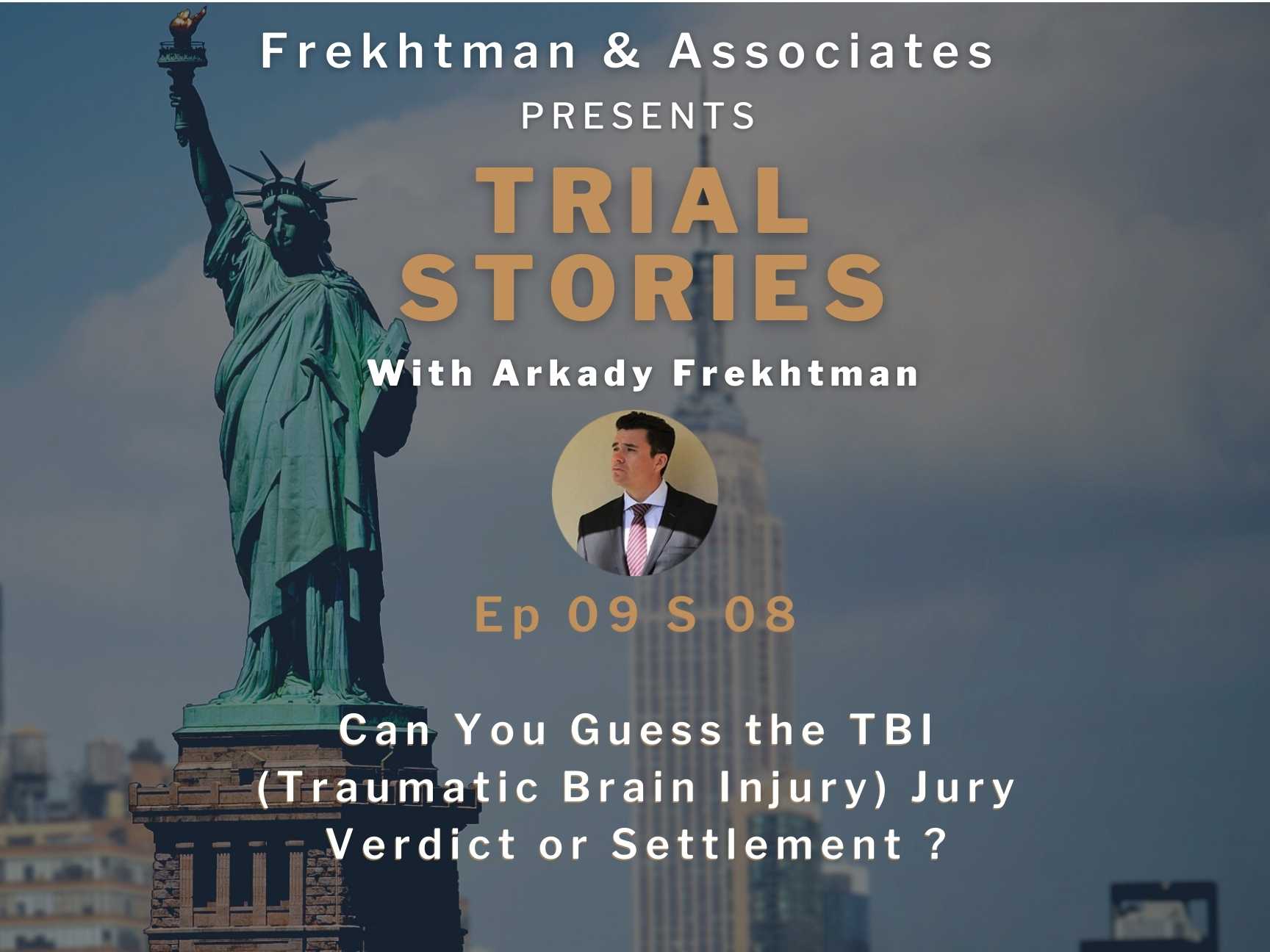EP 09 S 08: Can You Guess the TBI (Traumatic Brain Injury) Jury Verdict or Settlement ?

A deep dive into recent NY verdicts & settlements for Traumatic Brain Injury lawsuits in premises liability, car accidents, construction accidents, and medical malpractice. We also discuss mild traumatic brain injury (MTBI) and post concussive syndrome verdicts.
Pick Your Favorite Channel: Apple Podcast | Google Podcasts | Spotify | Stitcher | RSS
Full Transcript
Welcome to Trial Stories, an informative discussion of civil justice with a focus on the human story. I’m your host, Arkady Frekhtman, a New York City trial lawyer passionate about helping serious injury victims and their families. Hi everybody. This is Arkady Frekhtman and welcome. Our channel Today, we’re going to talk about traumatic brain injuries, and we’re going to look at verdicts.
We did a similar video about spinal fusions in New York, and today we’re gonna look at recent New York verdicts and settlements for traumatic brain injury. All types of brain injuries, mild traumatic brain injuries, post-concussive syndromes, and maybe even a little bit about just concussions in general because a concussion is a type of brain injury.
So let’s get started. It’s interesting, I did a little bit of research. I have the cases here on my screen, so I’m going to, Read a little bit and maybe look at the cases. I highlighted some information. I’m going to share it with you and we can discuss it and analyze it. And I think it’s really important for anyone who’s either dealing with a case of mild traumatic brain injury themselves.
Contact our team at (212) 222-1111 for your free case evaluation.
Or somebody who’s just interested in learning about how the law works, because the ultimate goal of the law is to put the person back in the same position they were in before they got injured. And if it’s an injury of their executive functioning right, of their prefrontal cortex or of their executive functioning of their brain, that’s what makes someone who they are.
So an injury to the brain is a life-changing. Forever injury. And so it is just so catastrophic and it changes the person, it changes the relationship of the person to their family. It changes their ability to work, it changes everything about that individually. So how does the law compensate someone for a brain injury?
So here’s the first case. The first case was actually against the United States of America. It was for a. And it happened in it happened here in district court, in federal court, in the southern district, which is in Manhattan. And it was a case that was resolved in May of 2020 during the pandemic, and it actually settled.

Treatment at a healthcare facility funded by the defendant, the United States of America. That’s why it was in federal court because it was against the federal government. And she received this treatment at a healthcare facility over 22 months. And so the complaints, the reason she went to the healthcare facility in the first place, she had some spitting up, coughing, choking, and some respiratory difficulties.
And so she filed a lawsuit under the Federal Torque claims, which allows you to sue the federal government, like for example, the case against the United States Post Office. That would all be if you get hit by a postal truck. That would all be Federal Torque Claims Act. And these cases are defended by the Attorney General, the US Attorney General.
And so the case settled for 5 million. 5 million straight. Okay, let’s go to the next case. The next case is a case in Queens County. And it settled in December of 2018 and it was a construction accident. There was actually a verdict in this case. It wasn’t a settlement, I apologize. It was an Asian man who was a brick layer, and what he claimed was that he suffered a traumatic brain injury with post-traumatic seizures.
He also had bilateral subdural intracranial hemorrhage edema with cranial pressure, which rendered him unable to care for himself, resulting in placement in a long-term care facility. So this was a very serious brain injury. He had fractures in the calve, non-displaced fractures of the parietal bone reactive thrombocytosis respiratory failure.
Plural effusion, facial traumas, tongue lacerations. So all this happened when he was working on an elevated platform or scaffold at a construction project owned by a company, an L C, Limited Liability Company, and they were the general contractor. And what happened was that the entire platform collapsed, and he fell to the ground, landing on his head.

So if the worker is standing on a ladder or a scaffold or any kind of elevated platform and they fall an appreciable height, let’s say, five feet or more, 10 feet, 20 feet, anything like, Any kind of height, gravity related, then the worker is protected and the liability is already determined as a matter of law.
The only question is the damages, and the damages in these cases is usually very high because you have serious injuries, pain, and suffering. You have noneconomic damages, including loss of enjoyment of life. You have the wages, the worker would be earning, and workers tend to be young, so you’d have future wages if it’s a serious injury for the rest of their life, up until times when they’re like 75.
Then you have the union benefits, so you need an economist. You might need a vocational rehabilitation expert. So here in this case, they had all of that and they won summary judgment. And they stipulated that medical expenses would be 1.3 million. So I guess they had the medical records, and they knew what the medical costs would be, and so they stipulated medical expenses.
Contact our team at (212) 222-1111 for your free case evaluation.
And so the total verdict, the verdict in this case was 22 million. A very high verdict in Queens. A very good result. And ultimately, There. Part of the verdict was the 1.3 that would be added to the verdict because the parties both stipulated the medical expenses. Then the plaintiff’s spouse filed a claim for loss of services, and that part of it was 4 million for the spouse, for the loss of services, the loss of consortium, because she lost.
Basically like her husband, not only as a companion, as somebody who’s the marriage, right? I was really affected because the husband now has to live in an adult care, long-term care facility, and it’s a very serious life-changing forever injury. So she loses everything, right? The intimacy, and the companionship basically lose her husband.
So actually, 4 million is low for that. But the total verdict was 22 million. Okay. And the next one is also a construction injury. And what happened here was it happened in the lawsuit was in also in Queens. And what happened here was let’s see here. Oh, this was actually a security g a security guard, and she was working at a hospital that was undergoing renovations and she alleged a traumatic brain injury as well.

And the hardware, the door company, the acoustic, some kind of acoustics, they were all negligent in the management, maintenance, and control of the premises and for causing and allowing the existence of a dangerous and defective condition and for violating New York Labor Law Section 200. Now section 200 is a common law.
So basically, they have to have just a common law and be careful. They can’t be negligent, reasonable care. That’s a common law. Now, she might have had to allege the common law because she was working as a security guard, so she wasn’t the construction worker. If she were a worker, then she would be alleging maybe 2 40 16, an industrial code violation under title 23 or two 40.
If it was gravity, this sounds like it could be gravity. But it would have to be, if something fell on her head, it would have to have fallen a falling object, and it would have to be an object that was being hoisted or secured as part of the construction. So she sounds like she might not have been part of the construction.
But anyway the damages were disputed and at trial, the jurors had to answer the question of whether the defendants were negligent, number one and second if they were neglige. Was their negligence a substantial factor in causing the accident, and the jurors responded yes to both questions. Then it was time to allow for damages, and the jurors allowed for 12,855,787, including 3 million for past pain and suffering and loss of enjoyment of life.
7.95 million for future pain and suffering. And the loss of enjoyment of life and 117,000 for loss of future social security retirement income. So that was another Queen’s case. Okay. The next case is a case that happened actually a while back in July of 2015, and this was a motorcycle crash. What happened here was,
Contact our team at (212) 222-1111 for your free case evaluation.
The primary injury was brain damage. Oh, now it’s a very, also very serious injury. So what happened here was the injury was brain damage, including a 19-day coma, a scalp pulsion, which exposed brain matter, and multiple facial and orbital fractures. Bilateral frontal encephalomalacia hydrocephalus with enlarged ventricle.
So very serious injuries result in deficits in speech, language, attention, intellectual functioning, short-term memory, left eye, vision loss, and depression. And this all happened because of a public roadway head-on collision between a motorcycle that the plaintiff was riding on and a car owned by the defendant who was an individual.
And after everything got made worse, it was called a disaster. Because a security guard who worked for a local hospital nearby hospital slammed the plaintiff’s head into a corkboard three months after the motor vehicle accident. So this is an interesting case. I think what happened was because of the serious brain injury in the motorcycle crash, the plaintiff was suing an individual, right?
The driver of the car crashed into him. He was in a hospital. Because of his injuries, a nearby local hospital in Queens, New York, and was exhibiting signs of erratic behavior, disruptive, unsafe behavior. And then the security guard in the hospital battered him, took his head, and hit it into this board.

So he almost had two cases in one, and ultimately the jury said that 55% was the fault of the driver that hit him and 45% was the fault of that security guard or hit his head into the board. And they allowed for. I think 14 million for pain and suffering related to the motor vehicle crash.
And the total verdict was 16 million. So I guess the rest of it was because of that security guard. It’s yeah, it’s an interesting case. Maybe later in another video, I could look at that PJ I section if anybody’s interested in; talk about how that works when you have two cases, and you could sue for two cases in one; it’s interesting.
Okay. The next one is a really big case also in Queens. For some reason, a lot of these cases are in Queens. This was a construction accident and what happened here was that a 20-year-old male construction worker suffered a traumatic brain injury it resulted in permanent cognitive. And he suffered multiple rib fractures, multiple spinal fractures, a renal hematoma, a splenic laceration, and a lung contusion.
And he was working at a construction project at premises owned by the defendant, and he was using a pole to prevent the suspended basket from hitting newly installed siding on a garage. And he fell 20 feet from the roof. And he argued that the owner. And the general contractor violated labor law section two 40, which is the gravity, the EL elevation, right?
That’s you get a summary judgment as a matter of law. And then, the defendant denied liability and argued that the plaintiff was provided with all the proper safety devices. And the plaintiff’s employer agreed to indemnify the defendants up to the limits of its primary and excess insurance policies. So the total verdict here was actually 62 million, $60,086.
So that was a really big verdict. I guess the injuries were just so drastic that it went for a really big amount. So this was actually this is, there are more cases here. This is a. So when you search for the jury verdict, so you can sort the verdicts, right? So this is a list where the ultimate award, whether it’s a settlement or a verdict, was higher than a certain amount, I think 5 million.
So these, that’s the highest that you could go. So that’s why some of them are five, some of them are 12, 16, and the highest, I think 62. The next one is 18 million. But basically, you could do searches just for like brain injuries in general, and you get all. So let’s take a look at that because don’t want to just limit it to these really monster, huge verdicts and give people an impression that all cases are so high.
There are also cases that just go from 1 million to 2 million. There are cases that go from 2 million to 5 million. And then there, there are cases, for example, where you could just search the term mild traumatic brain. And then you get all the cases for mild traumatic brain injury. Now that’s known as an M T B I.
And I’ve said before in other videos that I believe mtbi I is a misnomer. There’s no such thing because a brain injury is a serious injury to your brain, to someone’s head to their brain. It cannot be mild. So the reason it’s called mild is because of different classifications, different things.
Contact our team at (212) 222-1111 for your free case evaluation.
Ultimately, there’s no such thing as a mild traumatic brain injury. But I wanted to put that word in there to see if there are cases that are smaller because the doctors come to court and they say, this is an M T B I. Is that, is the framing right? Is the way you call something, would that affect the ultimate result?
So let’s take a look. Here’s a case. Here’s a case of M T B I that happened also in Queens. And what happened here was a person was a woman actually was working as at a shipping company, and she claimed mild traumatic brain injury, post-concussion syndrome, persistent headaches, dizziness, difficulties with speech, memory and concentration, herniated discs in her cervical neck and cervical radiculopathy.
The traveling pain down to the. She said she needed interventional pain management disc decompression surgery, and what happened was she was struck on the head by a piece of ice that fell from an awning as she was walking by a building owned by the defendant. It was like a condominium building, and she argued that the defendant was negligent in allowing the premises to be in this unsafe condition with accumulated.

And they had a bifurcated trial, meaning that first, there was a trial about who was at fault or liability, and then there would be a trial about damages. So in the trial on liability, the plaintiff won, and they said, yeah, it was dangerous. But then, on the trial on damages, they allowed for 100,000.
And before the trial started, the parties entered into a high low, where the high would be 500,000. So even if she got one of those verdicts, we just talked about 18 million. She would just get 500,000 cause that’s the high, and then the low was 75,000. So, if the jury said, you know what, you’re a faker.
Get zero, get out of here. She would still get the 75. So she had that low, the protection of 75,000, and she had a high of 500. So she agreed to that with her lawyer. You don’t have to agree to that, but she did. She chose to. That’s a choice that you could make to give you some. . So anyway, so the verdict was 100,000.
So she beat the low, but she didn’t she was not able to get as much as probably she wanted. And I’m not, know; I don’t know the details of the case. I don’t know why it happened. I know the doctor that testified is pretty good, the neurologist. I’m just looking at the case here.
It also happened in Queens. A lot of it depends on, what kind of jury you pick. But that’s just one case for mtbi. The next case for M T B I, this just remembers this is just searching the word mild traumatic brain injury. You put it in quotation marks, so you’ll only get that search term.
And now the next case was only 50,000, which is very low also. And what happened was a bicyclist who was a child was riding a bicycle, and he was listening to music on, actually on her cell phone, and swerved into the path of a car. And she was not wearing a helmet and suffered a fracture of the right sphenoid bone, a right temporal hematoma, and a mild traumatic brain injury.
And they reached a 50,000 structured settlement because maybe they were at fault if they were listening to headphones and just swerved. But they did some kind of annuity to get more money out of it. But 50,000 is pretty low. This is a case from Albany too. It’s upstate New York, so maybe that would.
Okay, the next case here was a case where a pedestrian was crossing a roadway. It happened in it was actually in the southern district, federal court. And it looks like, yeah, it looks like it was also mild brain damage. It was an adult female house cleaner. And she claimed that she suffered post-traumatic headaches secondary to mild traumatic brain injury, a cervical sprain or strain, herniated cervical and lumbar discs, and radiculopathy at C 67 L five S one.
That’s lumbar. The L five C is the cervical, which is the neck. She had a right meniscal tear, and she was attempting to cross the street when she was hit by a car owned by the United States of America’s Postal Service. Also, federal TUR claims. That’s why I went to the Southern District, and there was a trial.
And ultimately, she got zero. They just didn’t like the liability. I’m not sure. It doesn’t say exactly why. I guess they were arguing that the postal truck driver failed to see what there was to be seen because they moved from a parking position when it was not reasonably safe to do. Still, the defendant denied liability and argued that the plaintiff’s injuries were caused were not caused by any contact between the plaintiff and the car,, the postal vehicle, and argued that the plaintiff was negligent in walking across the street without a cross.
And it claimed that she failed to mitigate her damages and failed to seek timely medical care, so that, yeah, the jury agreed and allowed for zero. Now remember, in federal court, it’s hard because the jurors are, sometimes, picked by the judge, so you don’t even get to do attorney. So that could also be a reason in federal court I think the Southern District will draw jurors from Manhattan as well as Westchester.

But yeah, I’m just looking through these verdicts. I can’t do every case, but just looking through these verdicts where we searched for mild trauma, we see another one for a hundred thousand, another defense, meaning zero. , another one for defense. Here’s 225,000. So I think if the doctors come to court and they argue that it’s a mild traumatic brain injury, it looks like what happens is the jurors, for the most part, give less money because it seems like it’s mild, it’s nothing.
It’s going to go away. So you don’t want to use that. And it’s a misnomer because all brain injuries are serious changes to your brain, permanent brain injuries, they’re not mild. So here’s what actually where it was mild, they, it was, it claimed that it was a mild traumatic brain injury.
It was also a construction labor law. Two 40, the height and the verdict were, it was actually a mediated settlement. So everyone agreed, but it was 2.2 million. So that’s a little bit. Want to see some high numbers for the mild people too. . Okay. So that’s the mild category. And then what other searches did I do?
The other search I did was post-concussive syndrome. I was just curious about that. Post-concussive syndrome. Because that’s also a type of brain injury, there’s literature out there, especially more recently, that says that a concussion is a brain injury and this is a post-concussive syndrome, meaning that you have the concussion, but then you have a syndrome of the concussion.
Contact our team at (212) 222-1111 for your free case evaluation.
It doesn’t just go away cuz like football players, they play football, they get a concussion, they have to be out for a week. That’s the protocol. And then if everything is back to normal they’re better. They can go back to play football and hope. Everything will resolve. But with this type of case with a post-concussive syndrome, it doesn’t go away.
It stays. So let’s see, some of these cases here’s a case. Here’s a case in Nassau County, which is Long Island with a herniated disc as well as post-concussive syndrome. It was a nine year old, and what happened was, He suffered two herniated discs. He was a backseat passenger of a car, driven by his mother, and the defendant was backing up and struck the front of the vehicle where the plaintiff was sitting.
And the plaintiff argued that the defendant was negligent and the defendant reportedly denied liability. So this was a case that I believe it’s settled. During trial, or it settled in August of 2020. In Nassau. Nassau is a fairly conservative venue. It settled for $20,000. So not a big number, we don’t really know.
Really nine year old shouldn’t have herniated discs, but at the same time, perhaps there was an issue with the case. The summary’s very short. So it’s hard to see what the issue is. Fairly low for herniations as well as post-concussive. Here’s another one with post-concussive in Nassau County, and this one settled for 17,500.
So you see once you start using words like post-concussive syndrome, mild traumatic brain injury, the numbers go way down. If you have a true traumatic brain injury. 60 million, 18 million, 12 million. And when you have, more oh, I have a concussion, people think that’s gonna go away.
It’s not permanent and the numbers are much smaller.
Video Version:

Contact our team at (212) 222-1111 for your free case evaluation.




